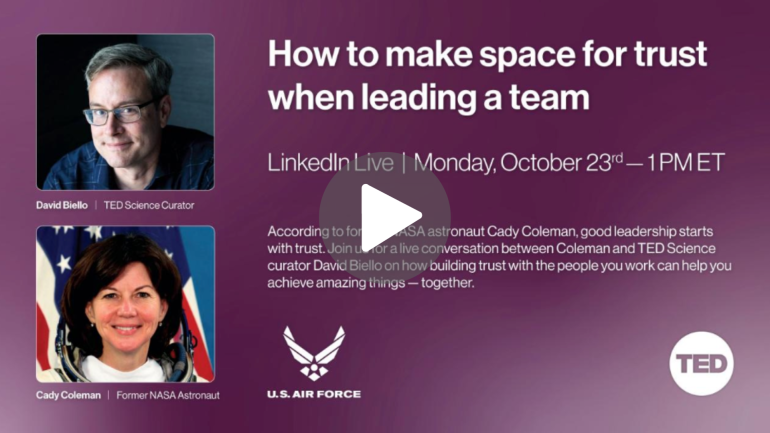
What does leadership look like?
While there are various approaches to leading a team, many of us land on common questions in the search for an effective leadership style: How can I be there for my team? Do I need to command respect, or earn it? And the most crucial question of all: How can I make sure that my team trusts me?
Cady Coleman has been confronting these questions throughout her career as a chemist, engineer, Air Force colonel and astronaut. In conversation with TED science curator David Biello, Coleman shared three strategies to establish — and maintain — trust in a leader. Whatever your career is, these tips can help you to prepare your team to face any challenge you come across — in outer space or here on Earth.
People often say, “There’s no ‘I’ in team” … But maybe there should be.
1. Be brave enough to get to know your team members as individuals
People often say, “There’s no ‘I’ in team”… But maybe there should be, says Coleman. Every member of your team is a whole person, and since so many of the problems we face at work are interdisciplinary, understanding who each individual is beyond the 9-to-5 is valuable. Being vulnerable enough to get to know your team this way is an essential skill for any leader.
When you are able to say, “I think your world is different from mine, and I’d like to understand more about it,” you’re not just building trust; you’re opening a communication channel that teaches you more about your teammate’s qualities, says Coleman. This type of conversation requires the willingness and bravery to be vulnerable. Once you know what everyone brings to the table, you can foster the growth of qualities that can lead the team to collective success.
For example, as Coleman prepared for life on the space station, her advisors warned that the long periods of time away from family might be too much to handle. For her, however, this wasn’t a problem — she had been commuting and working away from her family for more than a decade. After sharing her experience, her colleagues realized she’d not only be adaptable to life on the space station, but also she could help others cope with the change, too.
2. Create a culture that’s open to everyone’s ideas
While leaders have to guide their teams, it’s equally important to let everyone know that they can advocate for themselves and bring their own ideas to the table.
Coleman benefitted from such leadership at NASA when she was training to go to the space station. In the face of budget cuts, NASA announced that they’d be eliminating their smaller space suits, meaning that if someone wasn’t qualified to use a larger space suit, they couldn’t go to the space station. This presented a choice for Coleman: wait for NASA to acquire suits that fit her or figure out how she could train in the larger suits. By working with NASA’s decision makers, Coleman was able to shift her training to use the bigger suits. Had she not felt the freedom to speak up, she says, she would have been waiting 10 years to go to the space station in a small suit.
When you make trust-building a central goal, the rest falls into place more easily.
3. Make trust your mission
Sometimes establishing trust in the workplace can be more difficult than you expect, but when you make trust-building a central goal, the rest falls into place more easily. Workplace dynamics are always changing — maybe a teammate’s work/life priorities have shifted, or a big mistake requires you all to work together under new pressures. These challenges make fostering trust tricky, but they are also moments of opportunity.
If a new challenge has arisen or trust has been breached, Coleman reminds us to “always figure out the why and the what.” Make sure to ask: why has this happened, why do they feel this way, and what can be done about it? Be open to different points of view, and don’t give up if you don’t get through at first. Connection is often in the smaller things you do; talk about food or music, write a note to compliment an idea and ask to hear more. This level of connection and vulnerability may not seem intuitive at first, but as you make trust a core part of your mission, it becomes easy.
Trust, Coleman reminds us, is both given and earned. As a woman, she knew gaining the trust of some male colleagues might be extra challenging. Her approach was simple: she performed well and, with patience and persistence, learned her colleagues’ language and taught them hers. The challenges in gaining trust will always be there, but if you model vulnerability, openness and understanding for your team, you’ll find the rewards will always be there, too.
This post was adapted from a recent LinkedIn Live conversation with Cady Coleman, former NASA Astronaut and author of the forthcoming book, Sharing Space: An Astronaut’s Guide to Mission, Wonder, and Making Change, due out July 2024.
Watch the full LinkedIn conversation here:

A message from our partner the United States Air Force: The mission of the United States Air Force is to fly, fight and win — airpower anytime, anywhere. Whether full-time, part-time, in or out of uniform, everyone who serves plays a critical role in helping us achieve mission success.













